Procedure 2-1: Install software generic (initial) via FTAM
 Overview
Overview
Use this procedure to install the software generic via the File Transfer and Access Management (FTAM) protocol in a factory-fresh LNW2 SYSCTL. A factory-fresh SYSCTL circuit pack does not contain a software generic; it only contains the information loaded at the factory (boot code).
To install the software generic via FTP, refer to Procedure 2-2: Install software generic (initial) via FTP.
Important!
You must have OSI connectivity (via your OSI LAN or DCC) to the network element to use FTAM.
 Privilege level
Privilege level
You must log in as a Privileged user to complete this procedure.
Required equipment
In addition to Required equipment listed in this chapter, the following equipment is also required:
-
CAT5 Ethernet cable with either a 10/100 hub or a cross-over cable for the LAN or IAO LAN port (required for TCP/IP connectivity)
-
Copy of the new system generic software program accessible from your PC.
-
Factory-fresh LNW2, system controller (SYSCTL), with two factory-installed non-volatile memory (NVM) cards installed
-
Current Alcatel-Lucent 1665 Data Multiplexer Extend (DMXtend) Software Release Description for the software generic being installed
 Before you begin
Before you begin
Before performing this procedure:
-
Refer to Before you begin and Electrostatic discharge in Chapter 1, Safety.
-
Refer to the Alcatel-Lucent 1665 Data Multiplexer Extend (DMXtend) Software Release Description for a description of any special considerations required when installing this version of software.
-
Unseat all circuit packs in the shelf, except the LNW2 SYSCTL to which you are downloading the new software generic.
Important!
This procedure is intended for new shelf installations only. Do not use this procedure to upgrade an in-service shelf.
Steps
Complete the following steps to install the software generic program via FTAM in a new shelf installation with only a factory-fresh LNW2 SYSCTL installed.
1 |
Important! A factory-fresh SYSCTL circuit pack does not contain a software generic; it only contains the information loaded at the factory (boot code). Verify that only a factory-fresh LNW2 SYSCTL is present in your Alcatel-Lucent 1665 DMXtend shelf; ensure that no other circuit packs are seated in the shelf. An LNW2 SYSCTL is required to install 9.1.x software; you cannot install 9.1.x into an LNW1 SYSCTL. | ||||||||||||||||||||||||||||||||||
2 |
Important! For software installation, ensure that two NVMs are present in the LNW2 SYSCTL. After the LNW2 is installed, if one or both NVMs are missing, NVM removed alarm(s) are issued and:
Refer to Step 3 for the complete listing of codes and required actions. Insert the LNW2 (SYSCTL) circuit pack into the slot labeled CTL in the center of the shelf using a steady pressure on both faceplate latches. Allow a few minutes for the pack to complete initialization. Result: The LNW2 SYSCTL exhibits the following visible cycles during initialization:
| ||||||||||||||||||||||||||||||||||
3 |
Observe the IND display on the LNW2 SYSCTL; the display indicates the state of the SYSCTL.
| ||||||||||||||||||||||||||||||||||
4 |
Connect the cross-over LAN cable from the Network Interface Card (NIC) on the PC to the front LAN port on the SYSCTL circuit pack faceplate and establish a WaveStar® CIT session. (When TCP/IP is enabled on the rear LAN port J17 IAO LAN, OSI is disabled.) Double-click the WaveStar® CIT icon on your desktop and login (if necessary), to start the WaveStar® CIT software on the PC. Refer to Procedure 14-2: Connect Personal Computer (PC) and establish WaveStar® CIT session. Result: The Network View appears. | ||||||||||||||||||||||||||||||||||
5 |
From the View: pull-down menu, select CIT OSI Neighbors. Important! This View: is not the menu bar item View → ...; it is located above the NE Name pull-down menu. Result: The CIT OSI Neighbor(s) are automatically detected. 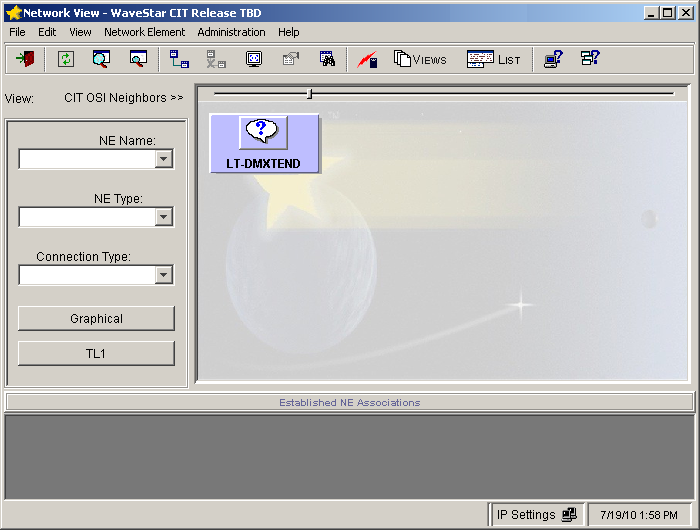 | ||||||||||||||||||||||||||||||||||
6 |
In the Network View, right-click the LT-DMXtend NE icon and select Graphical Using → OSI from the resulting menu. Result: The System Type Selection window appears. | ||||||||||||||||||||||||||||||||||
7 |
In the System Type Selection window, select DMXtend and click OK. Result: The NE Login Dialog window appears. | ||||||||||||||||||||||||||||||||||
8 |
Important! Because the shelf is in Maintenance Mode, your logins and passwords are default. Enter the following in the NE Login Dialog window (login information is case sensitive) to log in to the NE: User ID: LUC01 Password: DMXTND2.5G Click OK. Important! LUC01, LUC02, and LUC03 are the default privileged User IDs, and DMXTND2.5G is the default privileged password for Alcatel-Lucent 1665 DMXtend. To preserve the security of your equipment, it is highly recommended that you change all three logins and passwords during your first session after completing this initial installation procedure. Result: Screen 1 of 4 in the Maintenance Mode Wizard appears. Depending on the boot code of your SYSCTL (refer to Step 3), the title bar of the Maintenance Mode Wizard displays either DMXtend 4.0, DMXtend 5.0, DMXtend 5.1, DMXtend 8.0, DMXtend 9.0, or DMXtend 9.1. 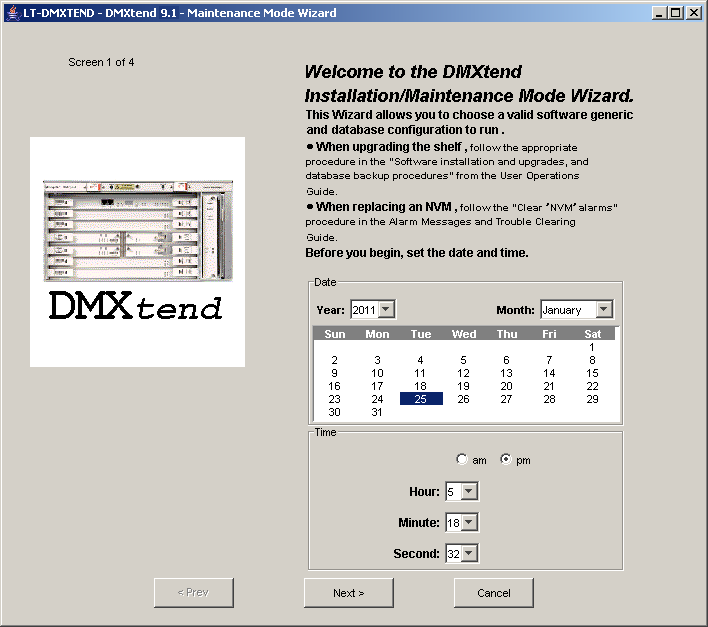 This screen picks up the time format preference from the WaveStar® CIT. You can provision the time format display for your WaveStar® CIT from the Network View by selecting View → Preferences and clicking the Display tab. This screen allows you to choose your preference for time format, either a 12-hour clock or a 24-hour clock.
| ||||||||||||||||||||||||||||||||||
9 |
Important! The actual time and date are preset from your PC. On Screen 1 of 4 in the Maintenance Mode Wizard, read the information, verify the date and time, make any required changes, and click Next. Result: Screen 2 of 4 in the Maintenance Mode Wizard appears. 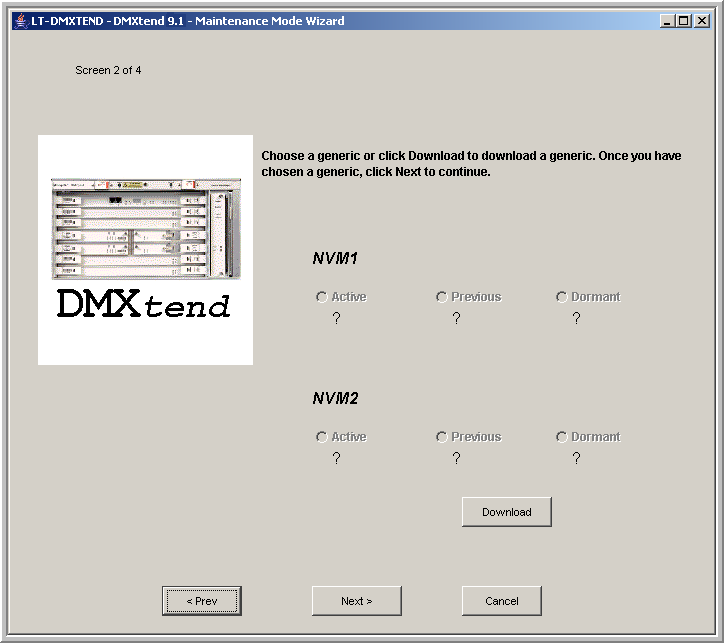 | ||||||||||||||||||||||||||||||||||
10 |
On Screen 2 of 4 in the Maintenance Mode Wizard, click Download. Result: Screen 1 of 3 in the Download Generic Wizard appears.  | ||||||||||||||||||||||||||||||||||
11 |
On Screen 1 of 3 in the Download Generic Wizard, read the information, select FTAM and click Next. Result: Screen 2 of 3 in the Download Generic Wizard appears. 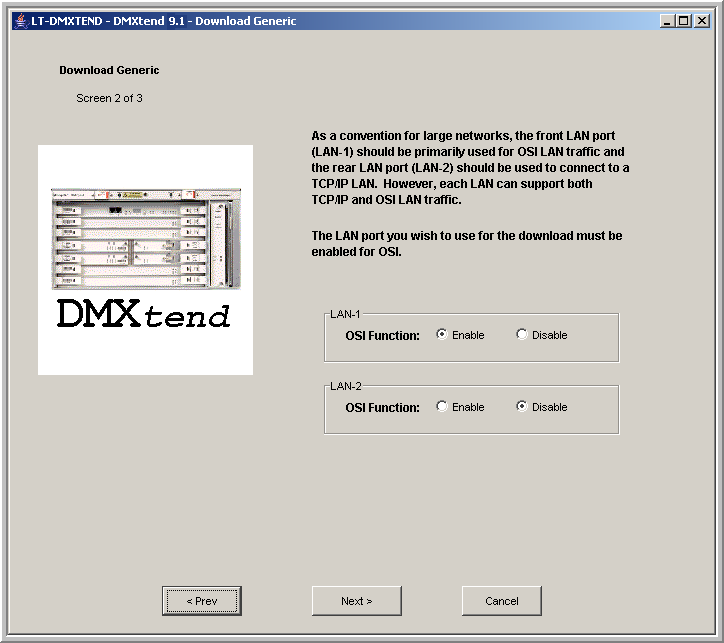 | ||||||||||||||||||||||||||||||||||
12 |
Important! LAN-1 is the LAN port on the faceplate of the LNW2 SYSCTL circuit pack. LAN-2 is the J17 IAO LAN port on the rear of the Alcatel-Lucent 1665 DMXtend shelf. On Screen 2 of 3 in the Download Generic Wizard, read the information, verify that the LAN port you are connected to has OSI Function Enable selected, and click Next. Result: Screen 3 of 3 in the Download Generic Wizard appears.  | ||||||||||||||||||||||||||||||||||
13 |
On Screen 3 of 3 in the Download Generic Wizard in the Path panel, enter the current location of the generic to be downloaded in the Path field or use the Browse button to select the generic to be downloaded. Click Download. The value of the Path field can be either an absolute path or a relative path that is relative to the root directory. The absolute path must start with the drive name followed by a colon (:) then the path names; for example: C:\Program Files\Alcatel-Lucent\WaveStar CIT\generics\DXT\9.1.0\p. The syntax of the relative path must start with the path name; for example: \generics\DXT\9.1.0\p. If you had an older WaveStar® CIT installed prior to installing the current WaveStar® CIT, your path could start with C:\Program Files\Lucent Technologies\. Result: A warning message appears listing the options you provisioned in the previous screens. | ||||||||||||||||||||||||||||||||||
14 |
Verify the information and either click Yes to start the download process or click No to return to the download screen and change your selections. Result: If you choose yes, the following initial software download progress indicator runs for approximately 30 minutes.  | ||||||||||||||||||||||||||||||||||
15 |
Once the software generic download is complete, the following confirmation message appears. Click Yes to use the generic that is now in the Dormant area. 
Result: Screen 3 of 4 in the Maintenance Mode Wizard appears. Depending on the boot code of your SYSCTL (refer to Step 3), your default database is either 4.0.x, 5.0.x, 5.1.x, 8.0.x, or 9.0.x. 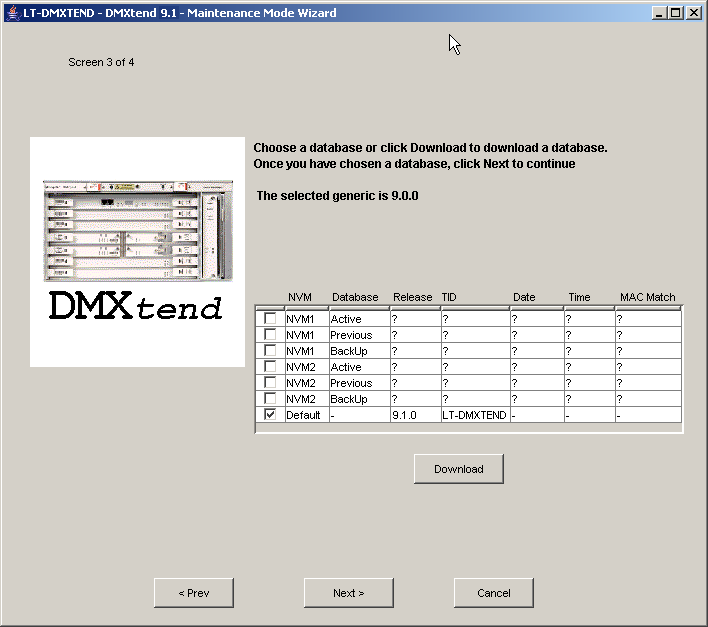 | ||||||||||||||||||||||||||||||||||
16 |
On Screen 3 of 4 in the Maintenance Mode Wizard, click the check box next to Default to create a default database and click Next. Result: When you select the default database, the following confirmation message appears. Since this is an initial installation, click OK to use default database. 
Result: Screen 4 of 4 in the Maintenance Mode Wizard appears. 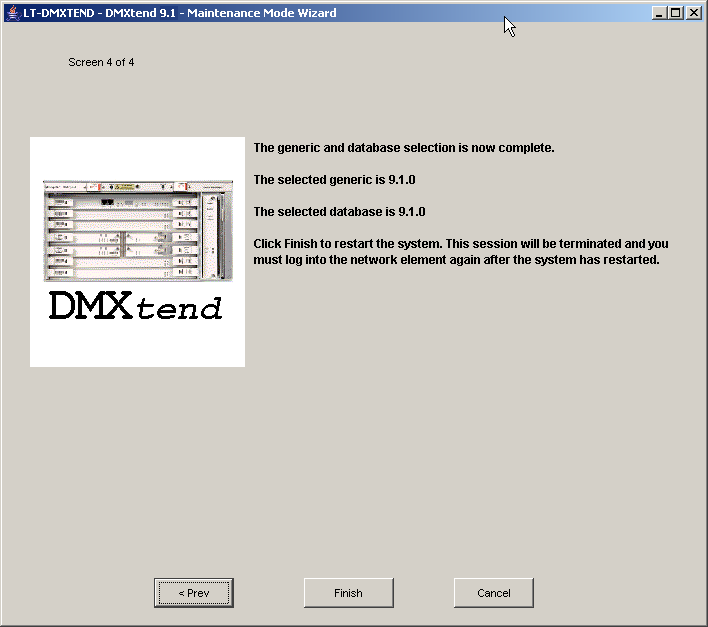 | ||||||||||||||||||||||||||||||||||
17 |
On Screen 4 of 4 in the Maintenance Mode Wizard, click Finish to restart the system and apply the generic and default database. Result: The Maintenance Mode Wizard closes and your connection to the shelf is terminated. The LNW2 SYSCTL exhibits the following visible cycles while the generic and database are installed and validated and the SYSCTL reboots:
| ||||||||||||||||||||||||||||||||||
18 |
What was the available default database on Screen 3 of 4 in the Maintenance Mode Wizard in Step 15?
| ||||||||||||||||||||||||||||||||||
19 |
If necessary, close the Maintenance Mode Wizard. From the Screen 4 of 4 in the Maintenance Mode Wizard, click Cancel and click Yes in the confirmation window. Result: The Maintenance Mode Wizard closes. | ||||||||||||||||||||||||||||||||||
20 |
In the Network View, right-click the LT-DMXtend NE icon and select Graphical Using → OSI from the resulting menu. Result: The System Type Selection window appears. | ||||||||||||||||||||||||||||||||||
21 |
In the System Type Selection window, select DMXtend and click OK. Result: The NE Login Dialog window appears. | ||||||||||||||||||||||||||||||||||
22 |
Important! Because the shelf is in Maintenance Mode, your logins and passwords are default. Enter the following in the NE Login Dialog window (login information is case sensitive) to log in to the NE: User ID: LUC01 Password: DMXTND2.5G Click OK. Result: Screen 1 of 4 in the Maintenance Mode Wizard appears. The title bar of the Maintenance Mode Wizard displays DMXtend 9.0.  | ||||||||||||||||||||||||||||||||||
23 |
Important! The actual time and date are preset from your PC. On Screen 1 of 4 in the Maintenance Mode Wizard, read the information, verify the date and time, make any required changes, and click Next. Result: Screen 2 of 4 in the Maintenance Mode Wizard appears. 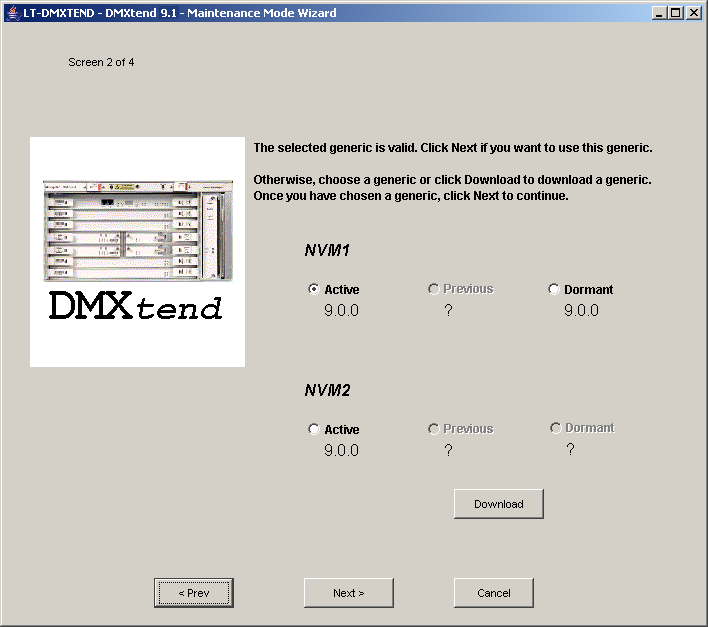 | ||||||||||||||||||||||||||||||||||
24 |
On Screen 2 of 4 in the Maintenance Mode Wizard, select Active on NVM1, and click Next. Result: Screen 3 of 4 in the Maintenance Mode Wizard appears. Your default database is 9.0.x.  | ||||||||||||||||||||||||||||||||||
25 |
On Screen 3 of 4 in the Maintenance Mode Wizard, click the check box next to Default to create a default 9.1.x database and click Next. Result: When you select the default database, the following confirmation message appears. Since this is an initial installation, click OK to use default database. 
Result: Screen 4 of 4 in the Maintenance Mode Wizard appears.  | ||||||||||||||||||||||||||||||||||
26 |
Repeat the procedure from Step 17. | ||||||||||||||||||||||||||||||||||
27 |
To verify that the download was successful, depress and hold the ACO TEST push-button on the LNW2 SYSCTL for about 4 seconds. Result: All LEDs on the shelf light. A red, 35-segment (5 x 7) rectangle appears in the IND display on the SYSCTL. Since the IND display is a 35-segment display, this test indicates all segments are working. | ||||||||||||||||||||||||||||||||||
28 |
Release the ACO TEST push-button on the LNW2 SYSCTL when the red rectangle disappears in the IND display. Result: The current software generic appears in the IND display on the LNW2 SYSCTL and the shelf LEDs return to their previous status. | ||||||||||||||||||||||||||||||||||
29 |
From the Network View of the WaveStar® CIT session you established in Step 4, select the View: pull-down menu and select CIT OSI Neighbors. Important! This View: is not the menu bar item View → ...; it is located above the NE Name pull-down menu. | ||||||||||||||||||||||||||||||||||
30 |
From the Network View, select View → Refresh OSI View. Result: The CIT OSI neighbor(s) are automatically detected. | ||||||||||||||||||||||||||||||||||
31 |
In the Network View, right-click the LT-DMXtend NE icon that was detected, and select Graphical Using → OSI from the resulting menu. Result: The System Type Selection window appears. | ||||||||||||||||||||||||||||||||||
32 |
In the System Type Selection window, select DMXtend and click OK. Result: The NE Login Dialog window appears. | ||||||||||||||||||||||||||||||||||
33 |
Enter the following in the NE Login Dialog window (login information is case sensitive) to log in to the NE: User ID: LUC01 Password: DMXTND2.5G Click OK. Important! LUC01, LUC02, and LUC03 are the default privileged User IDs, and DMXTND2.5G is the default privileged password for Alcatel-Lucent 1665 DMXtend. To preserve the security of your equipment, it is highly recommended that you change all three logins and passwords during your first session after completing this initial installation procedure. Result: The title bar of the System View and the legal notice text both reflect the current NE software generic, for example: 9.1.0. Reference: Procedure 14-2: Connect Personal Computer (PC) and establish WaveStar® CIT session | ||||||||||||||||||||||||||||||||||
34 |
Is the Generic Software Version correct?
End of steps |